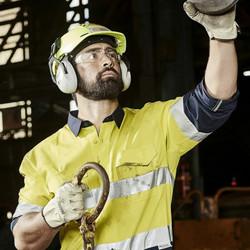Protecting Your Eyes and Feet: Safety Glasses and Shoes for Hazardous Work – Preventing Workplace Injuries

Workplace safety is more than just a checklist — it’s a responsibility. For anyone working in hazardous environments, protecting your vision and feet is non-negotiable. Two of the most critical pieces of personal protective equipment are safety eye glasses and safety shoes, supported by the right PPE clothing to create a complete layer of protection.
In this guide, we’ll explore why these items are essential, what features to look for, and how they work together to reduce the risk of workplace injuries.
1. Why Eye Protection Is Essential
Your eyes are extremely vulnerable to hazards such as flying debris, chemical splashes, dust, or intense light. A split-second accident can cause permanent damage, making safety eye glasses a vital part of any PPE kit.
Benefits of safety eye glasses:
- Impact protection – Shields eyes from high-speed particles.
- Chemical resistance – Prevents splashes from reaching the eyes.
- UV protection – Guards against harmful rays during outdoor work.
- Anti-fog and scratch resistance – Maintains clear vision in challenging environments.
Pro tip: Choose safety eye glasses that meet relevant safety standards such as ANSI Z87.1 or AS/NZS 1337 for guaranteed protection.
2. The Role of PPE Clothing
While safety eye glasses and safety shoes protect specific areas, PPE clothing provides body-wide coverage against hazards. From high-visibility vests to flame-resistant overalls, PPE clothing is designed to suit different industries and risks.
Why PPE clothing is important:
- Full-body protection – Shields skin from cuts, burns, and harmful substances.
- High-visibility – Keeps workers visible in low-light or high-traffic areas.
- Weather protection – Offers insulation, breathability, or waterproofing depending on the job.
- Regulation compliance – Ensures workplace safety standards are met.
Pro tip: Always select PPE clothing tailored to the hazards of your role — for example, flame-resistant gear for welding or waterproof layers for outdoor construction.
3. Safety Shoes – Your Foundation for Protection
Your feet carry you through long shifts and hazardous terrain, so keeping them safe is crucial. Safety shoes are designed to protect against impacts, punctures, slips, and even electrical hazards.
Key benefits of safety shoes:
- Toe protection – Steel or composite toe caps guard against heavy falling objects.
- Slip resistance – Specialized soles reduce the risk of falls on slippery surfaces.
- Puncture resistance – Protective midsoles block sharp debris from penetrating.
- Comfort and support – Cushioned insoles and arch support prevent fatigue.
Pro tip: Choose safety shoes designed for your work environment, whether it’s heat resistance for industrial work or waterproofing for outdoor tasks.
4. How They Work Together
Wearing safety eye glasses, PPE clothing, and safety shoes together creates a comprehensive defense against workplace hazards.
For example:
- Safety eye glasses protect against flying debris during cutting or grinding.
- PPE clothing shields the body from sparks, heat, or chemical spills.
- Safety shoes prevent foot injuries from falling tools or uneven ground.
This layered protection ensures no single area is left exposed.
5. Choosing the Right Gear
When selecting your safety eye glasses, PPE clothing, and safety shoes, focus on:
- Safety certification – Meets national or international standards.
- Comfort – Gear that’s comfortable is more likely to be worn consistently.
- Durability – Withstands daily wear and harsh environments.
- Fit – Correct sizing ensures maximum protection and mobility.
6. Maintenance for Maximum Protection
Your gear can only protect you if it’s in good condition.
For safety eye glasses:
- Clean lenses daily to maintain visibility.
- Replace if scratched, cracked, or damaged.
For PPE clothing:
- Wash according to manufacturer guidelines.
- Replace worn or torn garments.
For safety shoes:
- Keep them clean and dry.
- Replace if the tread is worn down or if the protective toe is compromised.
7. Common Mistakes to Avoid
- Wearing safety eye glasses without a secure fit, leaving gaps for debris.
- Using PPE clothing not designed for the specific hazards of your job.
- Wearing safety shoes that are uncomfortable, leading to inconsistent use.
8. Building a Safety-First Culture
Even the best gear is ineffective if it’s not worn consistently. Employers should provide training on the importance of safety eye glasses, PPE clothing, and safety shoes, while workers should take personal responsibility for wearing and maintaining their gear every day.
Final Thoughts
Protecting your vision, your body, and your feet is essential for staying safe on the job. Safety eye glasses shield against harmful debris, PPE clothing guards your body from multiple hazards, and safety shoes protect your foundation from injury.
By investing in high-quality equipment, maintaining it properly, and using it consistently, you significantly reduce the risk of workplace accidents. In hazardous environments, the right gear isn’t optional — it’s your best defense.
- Vibnix Blog
- Politics
- News
- Liberia News
- Entertainment
- Technology
- Educación
- Art
- Causes
- Crafts
- Dance
- Drinks
- Film
- Fitness
- Food
- Juegos
- Gardening
- Health
- Home
- Literature
- Music
- Networking
- Other
- Party
- Religion
- Shopping
- Sports
- Theater
- Wellness


